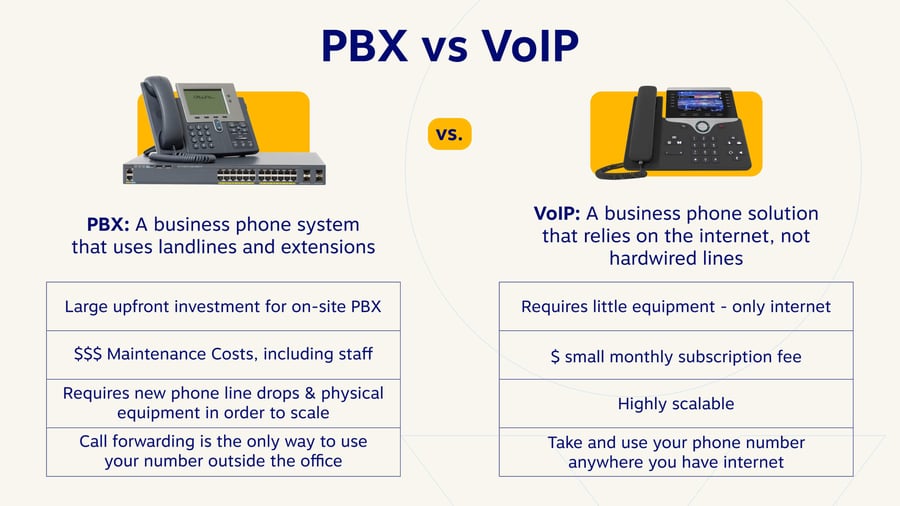Selecting the appropriate phone system is a crucial decision for any business, impacting communication efficiency, cost-effectiveness, and overall productivity. Two prevalent options dominate the market: the traditional Private Branch Exchange (PBX) and the modern Voice over Internet Protocol (VoIP). Understanding the nuances of each system is essential to making an informed choice aligned with your specific business needs and future growth plans. This article delves into a detailed comparison of PBX and VoIP, exploring their features, benefits, and drawbacks to help you determine which solution is the best fit for your organization.
Understanding Traditional PBX Systems
A PBX system is a privately owned telephone network used within a company. It connects internal extensions to external phone lines, enabling employees to communicate both internally and externally. Traditionally, PBX systems relied on physical hardware and dedicated phone lines.
Key Features of a Traditional PBX:
- On-site Hardware: Requires significant upfront investment in hardware and installation.
- Dedicated Phone Lines: Relies on traditional phone lines (PSTN) for connectivity.
- Limited Scalability: Expanding the system can be costly and time-consuming.
- Basic Features: Offers standard features like call forwarding, voicemail, and conference calling.
- Higher Maintenance Costs: Requires ongoing maintenance and support from specialized technicians.
Exploring the Advantages of VoIP Phone Systems
VoIP, or Voice over Internet Protocol, utilizes the internet to transmit voice data, offering a flexible and cost-effective alternative to traditional PBX systems. VoIP systems leverage existing internet infrastructure, eliminating the need for dedicated phone lines and costly hardware.
Benefits of Implementing VoIP:
- Cost Savings: Reduced call costs, lower maintenance fees, and minimal hardware investment.
- Scalability and Flexibility: Easily add or remove users and features as needed.
- Advanced Features: Access to advanced features like video conferencing, call recording, and mobile integration.
- Remote Accessibility: Employees can access the phone system from anywhere with an internet connection.
- Integration with Other Systems: Seamless integration with CRM, email, and other business applications.
PBX vs. VoIP: A Detailed Comparison of Features and Costs
Choosing between PBX and VoIP requires careful consideration of your business’s specific requirements. Let’s break down the key differences:
Feature Comparison:
While traditional PBX systems offer essential features, VoIP systems often provide a wider range of advanced capabilities, including:
- Unified Communications: Integrating voice, video, and messaging into a single platform.
- Mobile Integration: Allowing employees to use their smartphones as extensions.
- Call Analytics: Providing detailed insights into call patterns and performance.
- Automated Attendant: Streamlining call routing and improving customer service.
Cost Analysis:
The cost difference between PBX and VoIP can be significant. PBX systems involve substantial upfront investment in hardware and installation, along with ongoing maintenance costs. VoIP systems, on the other hand, typically involve lower upfront costs and predictable monthly fees.
Making the Right Choice for Your Business Communication
Ultimately, the best phone system for your business depends on your specific needs, budget, and technical capabilities. If you prioritize reliability and have a limited budget, a traditional PBX system might suffice. However, if you seek flexibility, scalability, and advanced features, a VoIP system is likely the better choice. Before making a final decision, carefully assess your business requirements, compare different vendors, and consider a trial period to ensure the chosen system meets your expectations. The right phone system can significantly improve communication efficiency and contribute to your overall business success. Don’t hesitate to explore both options thoroughly to find the perfect fit for your organization’s future.
Beyond the Binary: Hybrid Solutions and the Future of Business Communication
But what if the choice isn’t so black and white? What if the answer lies not in a definitive “either/or,” but in a nuanced “both/and?” The landscape of business communication is evolving, giving rise to hybrid solutions that blend the reliability of PBX with the agility of VoIP. Imagine a system that leverages existing PBX infrastructure for critical internal communications while harnessing the power of VoIP for remote workers and international calls. This is the promise of the hybrid approach, a symphony of technologies working in harmony.
The Allure of the Hybrid Model:
- Best of Both Worlds: Retain the stability of your existing PBX while embracing the innovation of VoIP.
- Phased Transition: Migrate to VoIP gradually, minimizing disruption and maximizing ROI.
- Customized Solutions: Tailor your communication system to your specific needs, not the other way around.
- Resilience and Redundancy: Create a robust system that can withstand outages and ensure business continuity.
Whispers of the Future: AI-Powered Communication and Beyond
Looking further ahead, the future of business communication is being sculpted by the emergence of artificial intelligence (AI). Imagine AI-powered virtual assistants that seamlessly route calls, transcribe voicemails, and even anticipate customer needs. Picture communication platforms that proactively identify and resolve potential issues, ensuring uninterrupted connectivity. This is not science fiction; these are the nascent realities of tomorrow’s business landscape.
Envisioning the AI-Driven Communication Revolution:
- Intelligent Call Routing: AI algorithms that analyze caller intent and direct them to the most appropriate agent.
- Real-Time Language Translation: Breaking down communication barriers and enabling seamless global collaboration.
- Predictive Analytics: Identifying potential communication bottlenecks and proactively addressing them.
- Personalized Customer Experiences: Tailoring communication interactions to individual customer preferences.
The choice between PBX and VoIP is no longer a simple decision; it’s the starting point of a journey into the ever-evolving world of business communication. Embrace the possibilities, explore the options, and dare to imagine a future where technology empowers your business to connect, collaborate, and thrive like never before. The whispers of innovation are growing louder, promising a symphony of connectivity that will redefine the very essence of how we communicate.

